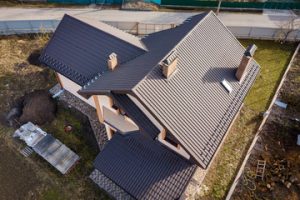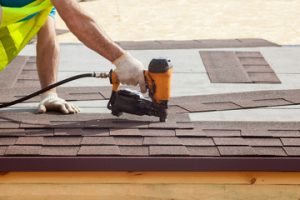Metal Roofing Erie PA offers a unique combination of durability, energy savings, and aesthetic versatility. They fit all architectural styles and are resistant to rot, mildew, insects, and fire.
However, proper insulation is essential to maximize the energy-saving benefits of a metal roof. With a combination of reflective barriers and foam insulation, homeowners can experience significant energy cost reductions while maintaining a comfortable indoor climate.

Reflective Properties
Metal roofs reflect solar radiant heat, which reduces cooling costs in the summer and helps make homes more energy-efficient. The long lifespan and low maintenance of a metal roof can also increase the resale value of a property, making it an excellent long-term investment for homeowners.
Because of their unique atomic structure, metals are highly emissive and readily transfer thermal energy. This is why metal roofing systems are so effective when it comes to reducing energy costs. Cool metal roofs absorb sunlight and quickly release the absorbed heat into the atmosphere, significantly cutting summer cooling energy costs.
In contrast, traditional asphalt shingles tend to absorb and retain heat, leading to higher indoor temperatures and increasing HVAC usage. Metal roofs, especially those with special coatings, can increase their reflectivity to further cut energy costs and improve efficiency.
The benefits of energy efficiency extend beyond the summer, as metal roofs help maintain interior warmth in the winter, reducing heating costs and helping businesses achieve their sustainability goals. These cost savings can also be offset by potential tax credits and incentives, further enhancing the ROI of a metal roof.
The durability of metal roofs is another selling point for potential buyers, as they can withstand heavy rainfall and high winds without showing any signs of wear or tear over time. They can also withstand extreme weather conditions, protecting the rest of the structure and creating a cohesive look that adds to a home’s overall aesthetic appeal.
Cool Roof Coatings
Metal roofs have come a long way from the corrugated tin that once adorned chicken coops and backyard sheds. Today, they can be found on homes, buildings, and commercial structures in a range of shapes and colors that fit a wide variety of architectural styles. They also boast a range of energy efficiency features that make them a smart choice for people with sustainability in mind.
In addition to the reflective properties they naturally possess, some metal roofs are available with specialized cool roof coatings that further enhance their energy efficiency capabilities. These coatings reflect solar power rather than absorbing it, which keeps the roof and the building beneath cooler and reduces cooling costs in warm climates.
Cool roofing can also help protect roof systems by reducing the thermal shock and wear caused by excess heat, which can shorten their lifespans. This helps extend the life of the roof, which can result in substantial cost savings over time.
With their excellent thermal emittance ratings, cool metal roofs are able to effectively release absorbed heat back into the atmosphere. This significantly reduces the energy demand of a building and decreases power bills, further contributing to energy efficiency and conservation efforts. As a bonus, this helps lower greenhouse gas emissions, which is another way that metal roofing supports sustainable initiatives.
Durability
Metal roofs are known for their durability, and they have a long lifespan compared to other roofing materials. This minimizes the need for frequent replacement, which reduces the energy that is used to manufacture and install new roofs. Additionally, metal roofs are more resistant to deterioration from harsh weather conditions.
Cool metal roofs are also highly emissive, which means that they reflect the sun’s heat instead of absorbing it. This helps to lower the surface temperature of the roof and decrease the amount of energy that is needed for heating or cooling. This translates into significant savings for homeowners, and it can even qualify them for potential tax credits.
Many homeowners choose to have their metal roofs painted with a reflective coating to increase their energy efficiency. This reflective surface reflects the sun’s rays, which reduces attic temperatures and saves on energy costs. Dark shingles, on the other hand, absorb sunlight and release it later in the day, which can raise utility bills and cost homeowners more money.
With so many different styles of metal roofs available, it’s difficult to know which one is the right choice for your home. From fitted whole-panel to shingle-like designs, there’s something for every residential property. Regardless of the style, metal roofs are durable and offer a range of cost benefits that can help to offset the initial investment.
Recyclable
The recyclability of metal roofs is an attractive feature for home buyers and building professionals seeking to reduce their environmental footprint. In addition to energy savings, a metal roof can last two to three times longer than traditional asphalt shingle roofs, which saves on replacement costs and creates less waste material.
The unique atomic structure of metals enables them to conduct thermal energy and rapidly disperse heat into the surrounding atmosphere. This property helps to lower cooling bills by keeping indoor temperatures more stable, reducing the need for constant air conditioning use. In contrast, asphalt shingles absorb sunlight and transfer heat into the structure.
As a result, buildings clad in asphalt tend to have higher cooling bills than those utilizing metal roofs. Metal roofing also contributes to the overall environmental health of a community, as it reduces urban heat islands and mitigates global warming.
When a metal roof reaches the end of its useful life, it can be recycled into new roofing sheets, plumbing components, and other products. This process uses significantly less energy than producing new metal, as well as a fraction of the energy consumed by mining and processing raw materials.
To ensure the quality of the recycled product, the shredded discarded panels are meticulously sorted based on their inherent qualities. Once reprocessed, the resulting metals undergo a variety of processes. Depending on the material, it may be melted and cast into blocks or rolled into sheets. These are then dispatched to factories for production into a wide range of consumer goods.
